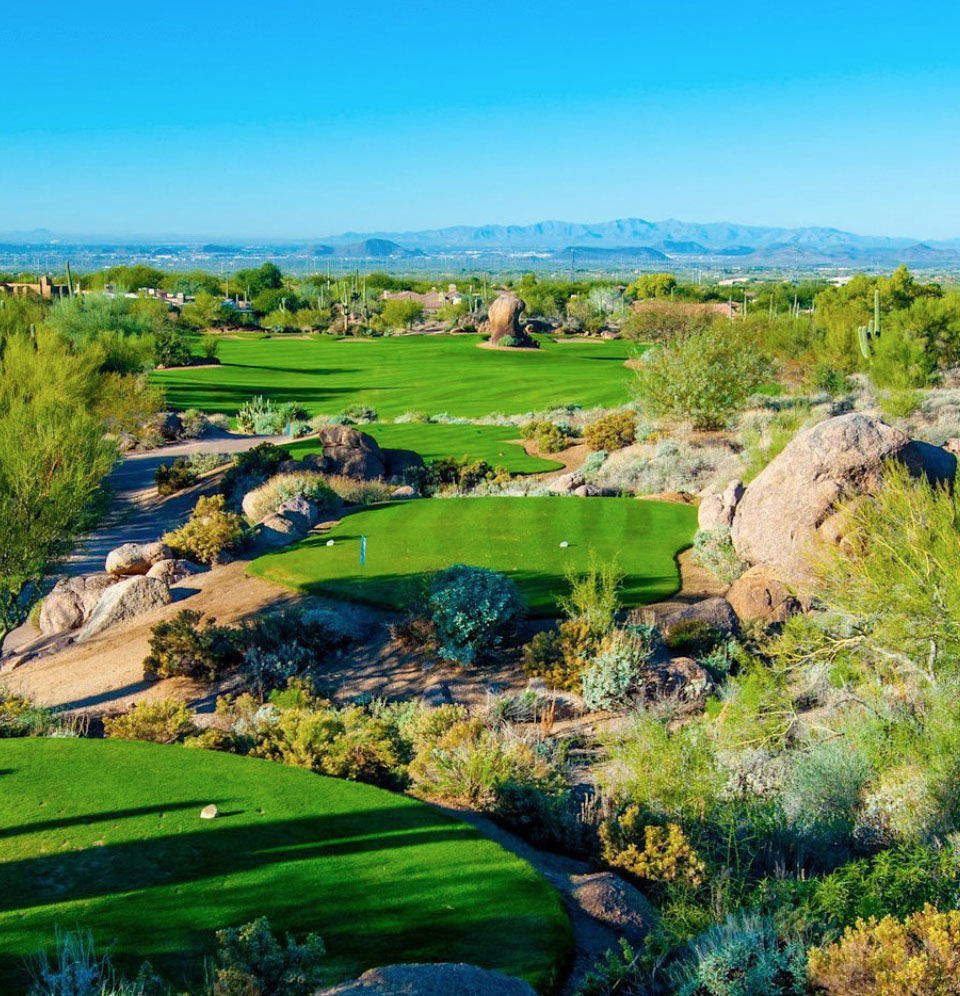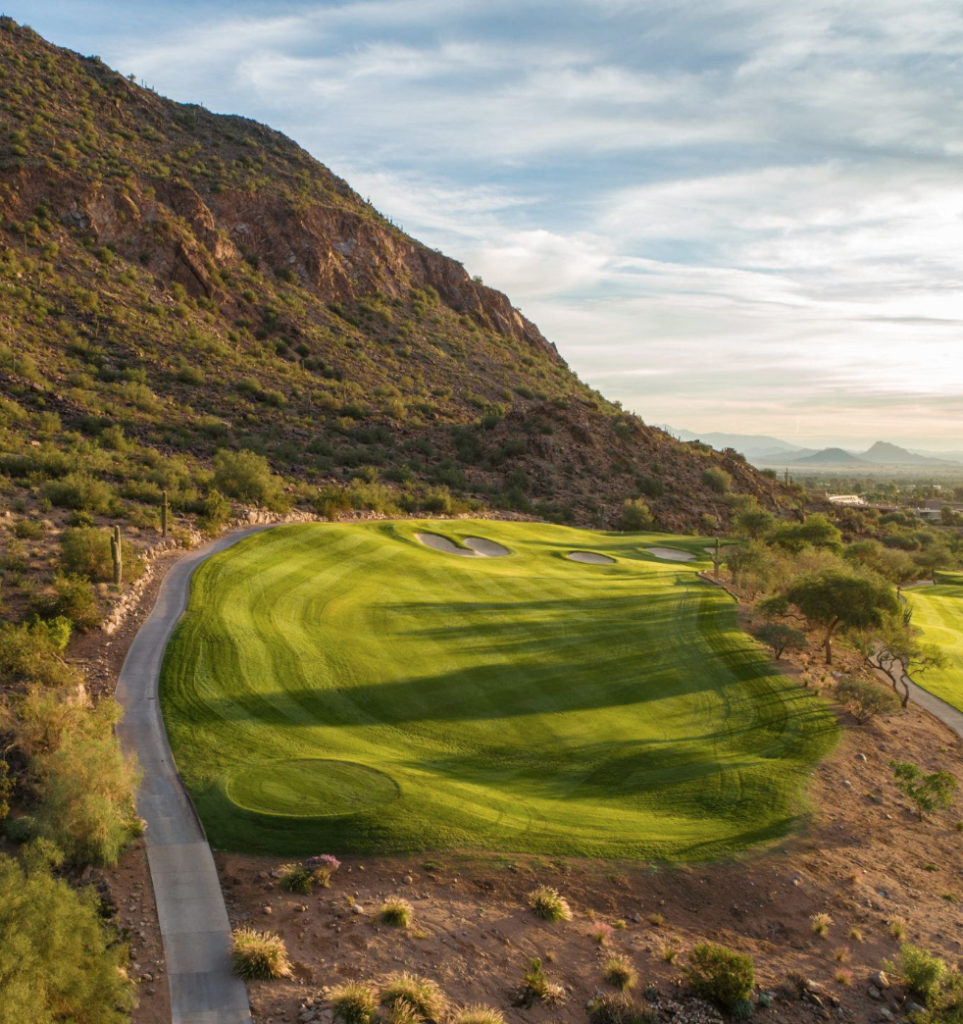
Quite simply, when you think of desert golf, you’re most likely picturing Arizona golf. Maybe it’s the giant saguaros that dominate the landscape and give those courses a beauty you just don’t find on most other desert landscapes in the United States.
Or maybe it’s the sheer volume of courses. For example, the Phoenix/Scottsdale area alone has more than 200 courses, and a sizeable chunk of them really are magnificent, especially when you get consider the lush overseeding in the winter.
With that volume, however, comes another attractive attribute — variety. For example, one of the state’s most famous stops, the Stadium Course at the TPC Scottsdale, home of the most attended golf tournament on the PGA Tour, is nothing like the two stellar courses at Troon North.
Some may argue that the TPC Course isn’t really desert golf, of course. With its wide fairways and turf all the way to the green, occasional thick rough and water hazards, you’ve got to be pretty wild to find the “desert.” But it is surrounded by desert nonetheless.

Golf in Arizona
Troon North, on the other hand, with the Pinnacle and Monument courses designed by Jay Morrish, Tom Weiskopf and Phil Smith, really is the pinnacle of desert golf. Ribbons of fairway cut through the gorgeous natural landscape with elevated tees and, at times, almost island greens complexes. The beauty of these courses — as well as the challenge — is stunning, especially in the winter time with the high contrast of deep green against the more subdued colors of the desert.
So what do you need to know if you’re (now) thinking about planning an Arizona golf excursion?
For most people, the first thing they need to think about is budget. Then it’s what type of courses do you want to play. Some are more player friendly than others. And are you looking for a good test of golf, beauty or both?

A budget for all players
Granted, going to Arizona in the winter time can be pretty pricey for many golf courses, but even then, you don’t have to pay $200 or more for green fees if you pick the right courses. If you’re willing to go off the beaten path, perhaps, say down toward Wickenburg, for example, you can put together a reasonable golf package. At Wickenburg Ranch you can get an afternoon tee time for less than $100 during peak season on its championship course, and it’s a really, really good course (plus there’s an awesome short course there, too).
For even more value, though, try Arizona in the shoulder seasons like late spring and early fall (before overseeding). And if you don’t mind playing courses with Bermuda grass in the summer, you can really save a lot of money then. Course likes Troon North and can be had for less than $100 in the summer, while many more high quality daily fee courses are less than $50 that time of year.
Also, if you’re considering Arizona in the summer, the Flagstaff and Tucson areas are a little cooler in the summer. Tucson, for example, is generally about 1,000 feet higher in elevation than the Valley of the Sun, which means Tucson has many more summer days that don’t reach triple digits.
Another idea, if you’re going to be in Arizona for an extended period might be to purchase an Arizona Troon Card. You can save up to 50 percent off at 22 Troon and OB Sports-managed courses in Arizona. For more information, go to Troon.com and click on the Troon Card option on the right.
A course for every player
While there are very few courses that discriminate against high handicappers, some are more player-friendly than others, and that certainly holds true with desert golf.
Perhaps that’s why most players, or even the facilities for that matter, implement the so-called “desert rule” in their rounds. In case you’re not familiar with it, it’s the local rule practice of dropping a ball with a one-stroke penalty on the edge of the grass where the ball (tee shots in particular) crossed into the desert to avoid searching for golf balls in the often inhospitable grounds that lie beyond the irrigated turf (think rattlesnakes, tarantulas and jumping cholla cacti).
Some courses are more apt to implementing the desert rule than others. In particular courses with wider fairways and more grass, and some that probably qualify for parkland in a desert setting, are certainly more player friendly. Because while the desert rule promotes safety and saves time, who wants to lose a dozen golf balls during the course of a round?
One of the most player-friendly layouts in Arizona has to be Scottsdale’s 27-hole Kierland Golf Club, a Scott Miller design with fairways surrounded by large grass slopes that funnel the ball back in play. It means you really have to hit a wayward tee shot to lose a ball there.
In Maricopa, Ak-Chin Southern Dunes, which is actually a bit of links-style course, has plenty of grass to land on as well. And you’ll find that kind of forgiveness at The Phoenician, too, which was reduced from 27 holes down to 18 holes a few years ago.

Desert courses can be dazzling
Still, if budget isn’t your primary concern, one of the most appealing aspects of desert golf is the beauty of many of these courses and their surrounds.
One of the most stunning is The Boulders in Carefree, Ariz., near Scottsdale. As its name would imply, the courses there are laid out among huge boulders and rock formations millions of years old. It’s awe-inspiring on every turn and both Jay Morrish-designed courses are always in A-plus condition and super interesting.
We-ko-pa Casino and Resort, which also has 36 holes, is another stunning option. With courses designed by Bill Coore and Ben Crenshaw and Scott Miller, We-ko-pa offers up superb championship golf and incredible scenery at every turn.
Or check out Papago Municipal in Tempe, right next to Arizona State University. Now the official course of the Sun Devils, Papago is an old parkland course surrounded by some of the most unusual giant red rock formations you’ll see anywhere. And since it’s a muni, it’s definitely affordable. Be sure to check out Papago’s awesome clubhouse, too, where you can relax with great food and drink at Lou’s Bar and Grill, which overlooks the course and driving range.

Of course we haven’t really even touched on the courses about an hour and half south in the Tucson area. There you get a whole different vibe. The Tucson area tends to be a little laid back and more value driven, although it has its share of high-end clubs.
For one, Tucson has an excellent municipal system that includes courses like Randolpho Dell Urich and Silverbell. Dell Urich is a strong 1996 Kevin Kavanaugh redesign by that has played host to several state championships. And Silverbell, a local favorite located on the west bank of the Santa Cruz River, is another rework by Kavanaugh. Both can be played for around $50 or less during peak season.
Tucson has its share of resort courses, too, like the Notah Begay-designed Sewailo Golf Club at Casino Del Sol. Opened in 2013, Sewailo is another course with lots of turf and water, so you really have to be offline to hit it in the desert.
Other top quality resort courses include Westin La Paloma, Starr Pass, Omni Tucson National Resort & Spa and The Golf Club of Dove Mountain, a 27-hole Jack Nicklaus Signature design that once played host to the Accenture Match Play.
And finally, if you’re golf film buff, then you might want to check out Tubac Resort, where much of the movie “Tin Cup” took place. This isn’t the course setting for the scene where Kevin Costner’s character empties his bag of golf balls going for a par-5 in two (that’s actually the Deerwood Club in Kingwood, Texas), but plenty of other memorable moments in the movie are depicted here for those who want to relive other movie moments. Plus, Tubac is a lot of fun.


